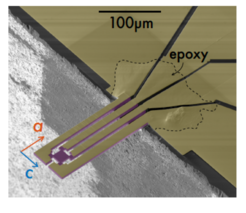Novel approach to non-uniform superconductivity
Superconductivity has fascinated scientists for many years both for fundamental reasons and because it offers the potential to revolutionize current technologies. Materials only become superconductors – meaning that electrons can travel in them with no resistance – at very low temperatures. These days, this unique zero resistance superconductivity is commonly found in a number of technologies, such as magnetic resonance imaging (MRI). Future technologies, however, will harness the total synchrony of electronic behavior in superconductors – a property called the phase. There is currently a race to build the world’s first quantum computer, which will use these phases to perform calculations. Conventional superconductors are very robust and hard to influence, and the challenge is to find new materials in which the superconducting state can be easily manipulated in a device.
In work begun during his time at our Institute, Philip Moll (now a Professor at EPFL in Lausanne) set up a project on a special superconductor, CeIrIn5, whose properties are unusually tunable. Maja Bachmann, supervised mainly by Philip, in collaboration with Andy Mackenzie of the Physics of Quantum Materials department, obtained intriguing results in which the superconductivity developed an apparent directionality when studied in specially made microstructures of CeIrIn5. Investigating this further involved a collaboration between Philip’s group and those of Elena Hassinger and Michael Nicklas, in addition to external collaborators at Los Alamos National Laboratory. Key insights were then obtained by joining forces with the groups of Brad Ramshaw and Katja Nowack at Cornell University. By analysing images such as those shown in the teaser figure, obtained from incredibly sensitive magnetic microscopy, Matt Ferguson and other members of Katja’s group were able to solve the mystery of what is going on. When the thin microstructured platelets are attached to a sapphire substrate and cooled, the sapphire and CeIrIn5 contract very differently. This can create regions of superconductor and others of normal metal in the same microstructure. Better still, they produced a model that allows the design of complex conduction patterns that can be distributed across devices in a highly controlled way. Philip’s new group at EPFL is now leading efforts to investigate the influence that these new techniques can have on the development of novel quantum technologies.

One of the goals of our Institute is to promote barrier-free collaboration between our departments and our independent research groups; this work is an example of the benefits that result from such an open collaborative philosophy. Without the broad-based collaboration that this project turned into, the work would have ended up being of considerably less significance.
Andy Mackenzie / APM
